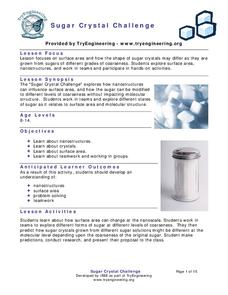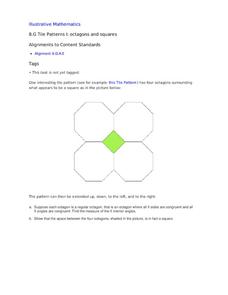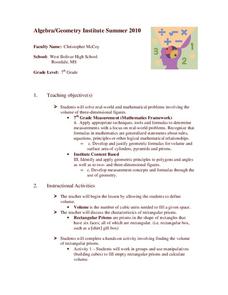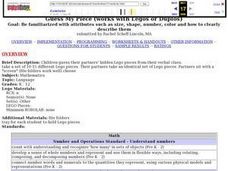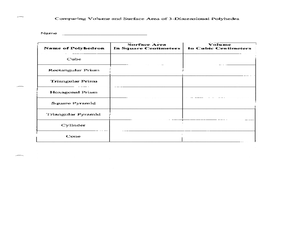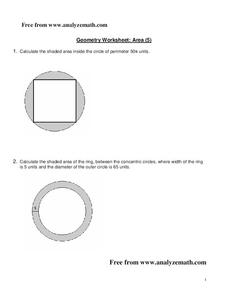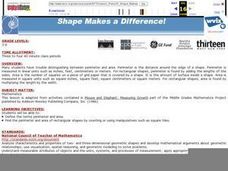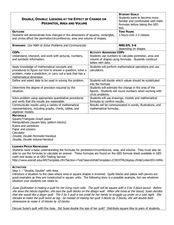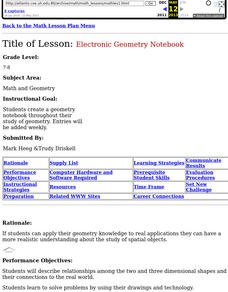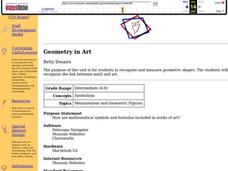TryEngineering
Sugar Crystal Challenge
Be sure to use this sweet resource. Scholars perform an experiment using sugar to investigate how surface area relates to the coarseness of sugar. They consider how this concept connects to nanotechnology.
Concord Consortium
Gravity
Weight is a function of the distance from sea level. Learners explore the many implications of this fact in an inquiry-based task. Given the function, pupils answer questions before manipulating the function to rewrite the distance...
Curated OER
Tile Patterns I: Octagons and Squares
This can be used as a critical thinking exercise in congruence or as a teaching tool when first introducing the concept. Four octagons are arranged in such a way that a square is formed in the middle. With this information, geometry...
Los Angeles County Office of Education
Assessment For The California Mathematics Standards Grade 4
Have scholars show what they know with a 20-page assessment aligned to the California State Standards. The test covers concepts such as large and whole numbers, all four mathematical operations, fractions, decimals, geometric figures,...
Curated OER
Measurements
Seventh graders solve word problems involving real world situation. In this geometry lesson, 7th graders solve problems related to volume. They apply the formulas taught in geometry.
Curated OER
Area & Perimeter
Learners define area and perimeter. They demonstrate understanding of the concepts concretely, with manipulatives, and describe with words, their strategies and thought processes.
Curated OER
Area And Perimeter
Fifth graders practice the skills of finding the perimeter and area of different objects. They integrate technology tools by using a computer software program during the class as the second half of an assessment of measuring student...
Curated OER
Guess My Piece -working with Legos
Students participate in guessing their partners' hidden Lego pieces from their verbal clues. They work in partners to accomplish their goals. They are meeting a variety of math standards by completing this lesson.
Curated OER
Tangram Perimeters
Students work together to make figures out of tangram squares. In groups, they calculate the measurements they need and apply the Pythagorean Theorem. They complete a worksheet solving equations using the theorem and review their answers.
Curated OER
Using Polynomials To Find Perimeter
Fifth graders engage in the solving of a real life application problem using the concept of calculating perimeter. They apply the operations of calculating with the polynomials for finding the perimeter of triangles,quadrilaterals, and...
Curated OER
Linear Graphs and Equations 5.1
In these identifying coordinates on a grid, linear graphs, and equations worksheets, 6th graders draw the shapes and letter, complete a table and use it to draw a graph, calculate gradients of lines, determine equations of lines, solve...
Curated OER
Application of Delta-Epsilon Definition of the Limit
Students create a Hexaflexagon using a formula. In this calculus instructional activity, students apply the definition of delta epsilon as it relates to limit to create a shape using creases. They relate the same rule to triangles and...
Curated OER
Solid Surface Area
Students calculate the area of solids. In this geometry activity, students use formulas to find the surface are and the volume of solids. They investigate 3-dimensional shapes.
Texas Instruments
Areas of Regular Polygons and Circles
Learners explore area of polygons and regular polygons in this math lesson. They calculate the area of several polygons using Cabri Jr. and analyze shapes and write formulas to solve for the area.
Curated OER
Finding The Area
In this geometry worksheet, students calculate the area of a given shape. They use the formulas for squares and circles to help them find the area. There are 2 questions with an answer key.
Curated OER
Side Length, Perimeter, and Area of a Rectangle
Students calculate area, perimeter and length of rectangles. In this geometry lesson, students create different formulas for the problem they are being asked to solve. They use the navigator to move the shape around and make observations.
Curated OER
Does the Area of the Quadrilateral Change?
Students study area and quadrilaterals. In this multiplication and area lesson, students use Polystrip models to change rectangles to form different parallelograms. Students find the area of the models use a Geometer Sketchpad to find...
Curated OER
Shape Makes a Difference!
Learners learn the difference between perimeter and area by watching a video and a hands on activity.
Curated OER
Double, Double: Looking at the Effect of Change on Perimeter, Area and Volume
Students explore perimeter, volume, and area. In this math lesson, students explore how changes in dimensions of geometric shapes affect the perimeter, area and volume of the various shapes. Students investigate the results when the...
Curated OER
Electronic Geometry Notebook
Students examine the relationship between two and three dimensional shapes. They use their drawings to solve problems. They create a notebook of the formulas and how they relate to the real world.
Curated OER
Geometry in Art
Learners examine mathematical symbols and formulas included in works of art. They analyze quilts for shapes and they each make their own quilt from squares using geometric shapes.
Curated OER
Area of Complex Figures
Fifth graders use formulas for calculating areas of squares and rectangles to find area of complex figure, compare their own ideas with their classmates' ideas, and recognize that there are multiple methods for finding area of complex...
Curated OER
Leveled Problem Solving Areas of Triangles and Trapezoids
In this geometry learning exercise, 6th graders calculate the area of triangles and trapezoids using the given formulas. They use the formulas to find measurements of lines that are part of the triangles and trapezoids.
Curated OER
Area and Perimeter Review
Students calculate the area and perimeter of different shapes. For this geometry lesson, students name the different polygons based on their number of sides. They use the correct formula for each shape to calculate the area and perimeter.
